Rnsg 2201 chapter - Study guides, Class notes & Summaries
Looking for the best study guides, study notes and summaries about Rnsg 2201 chapter? On this page you'll find 74 study documents about Rnsg 2201 chapter.
Page 4 out of 74 results
Sort by
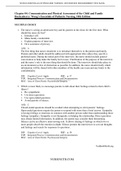
-
Chapter 04: Communication and Physical Assessment of the Child and Family Hockenberry: Wong’s Essentials of Pediatric Nursing, 10th Edition
- Exam (elaborations) • 24 pages • 2023
- Available in package deal
-
- $9.49
- + learn more
1. The nurse is seeing an adolescent boy and his parents in the clinic for the first time. What should the nurse do first? a. Introduce self. b. Make family comfortable. c. Explain purpose of interview. d. Give assurance of privacy. ANS: A The first thing that nurses should do is to introduce themselves to the patient and family. Parents and other adults should be addressed with appropriate titles unless they specify a preferred name. During the initial part of the interview, the nurse ...
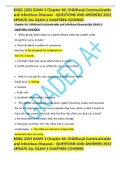
-
RNSG 2201 EXAM 2 Chapter 06: Childhood Communicable and Infectious Diseases - QUESTIONS AND ANSWERS 2022 UPDATE ALL EXAM 2 CHAPTERS COVERED
- Exam (elaborations) • 164 pages • 2022
-
- $27.98
- + learn more
RNSG 2201 EXAM 2 Chapter 06: Childhood Communicable and Infectious Diseases - QUESTIONS AND ANSWERS 2022 UPDATE ALL EXAM 2 CHAPTERS COVERED

-
Chapter 25: The Child with Cancer Hockenberry: Wong’s Essentials of Pediatric Nursing, 10th Edition
- Exam (elaborations) • 15 pages • 2023
-
- $9.49
- + learn more
1. The school nurse is discussing testicular self-examination with adolescent boys. Why is this important? a. Epididymitis is common during adolescence. b. Asymptomatic sexually transmitted diseases may be present. c. Testicular tumors during adolescence are generally malignant. d. Testicular tumors, although usually benign, are common during adolescence. ANS: C Tumors of the testes are not common, but when manifested in adolescence, they are generally malignant and demand immediate eval...
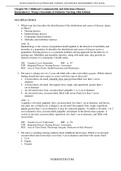
-
Chapter 06: Childhood Communicable and Infectious Diseases Hockenberry: Wong’s Essentials of Pediatric Nursing, 10th Edition ALL ANSWERS 100% SOLVED 2022/2023 EDITION RATED GRADE A+
- Exam (elaborations) • 16 pages • 2023
- Available in package deal
-
- $10.49
- + learn more
1. Which term best describes the identification of the distribution and causes of disease, injury, or illness? a. Nursing process b. Epidemiologic process c. Community-based statistics d. Mortality and morbidity statistics ANS: B Epidemiology is the science of population health applied to the detection of morbidity and mortality in a population. It identifies the distribution and causes of diseases across a population. Nursing process is a systematic problem-solving approach for the del...
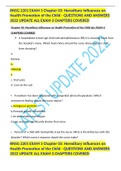
-
RNSG 2201 EXAM 3 Chapter 03: Hereditary Influences on Health Promotion of the Child - QUESTIONS AND ANSWERS 2022 UPDATE ALL EXAM 3 CHAPTERS COVERED
- Exam (elaborations) • 162 pages • 2022
-
- $25.98
- + learn more
RNSG 2201 EXAM 3 Chapter 03: Hereditary Influences on Health Promotion of the Child - QUESTIONS AND ANSWERS 2022 UPDATE ALL EXAM 3 CHAPTERS COVERED
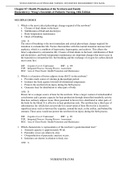
-
Chapter 07: Health Promotion of the Newborn and Family Hockenberry: Wong’s Essentials of Pediatric Nursing, 10th Edition
- Exam (elaborations) • 18 pages • 2023
- Available in package deal
-
- $9.49
- + learn more
1. Which is the most critical physiologic change required of the newborn? a. Closure of fetal shunts in the heart b. Stabilization of fluid and electrolytes c. Body-temperature maintenance d. Onset of breathing ANS: D The onset of breathing is the most immediate and critical physiologic change required for transition to extrauterine life. Factors that interfere with this normal transition increase fetal asphyxia, which is a condition of hypoxemia, hypercapnia, and acidosis. This affects ...
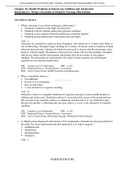
-
Chapter 16: Health Problems of School-Age Children and Adolescents Hockenberry: Wong’s Essentials of Pediatric Nursing, 10th Edition
- Exam (elaborations) • 15 pages • 2023
-
- $9.49
- + learn more
1. Which statement is true about smoking in adolescence? a. Smoking is related to other high-risk behaviors. b. Smoking will not continue unless peer pressure continues. c. Smoking is less common when the adolescent’s parent(s) smokes. d. Smoking among adolescents is becoming more prevalent. ANS: A Cigarettes are considered a gateway drug. Teenagers who smoke are 11.4 times more likely to use an illicit drug. Teenagers begin smoking for a variety of reasons, such as imitation of adult ...
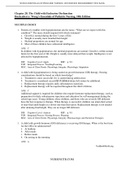
-
Chapter 28: The Child with Endocrine Dysfunction Hockenberry: Wong’s Essentials of Pediatric Nursing, 10th Edition
- Exam (elaborations) • 14 pages • 2023
- Available in package deal
-
- $9.49
- + learn more
1. Parents of a toddler with hypopituitarism ask the nurse, “What can we expect with this condition?” The nurse should respond with which statement? a. Growth is normal during the first 3 years of life. b. Weight is usually more retarded than height. c. Skeletal proportions are normal for age. d. Most of these children have subnormal intelligence. ANS: C In children with hypopituitarism, the skeletal proportions are normal. Growth is within normal limits for the first year of life. H...
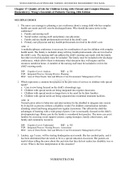
-
Chapter 17: Quality of Life for Children Living with Chronic and Complex Diseases Hockenberry: Wong’s Essentials of Pediatric Nursing, 10th Edition ALL ANSWERS 100% SOLVED 2022/2023 EDITION RATED GRADE A+
- Exam (elaborations) • 16 pages • 2023
-
- $9.49
- + learn more
1. The nurse case manager is planning a care conference about a young child who has complex health care needs and will soon be discharged home. Who should the nurse invite to the conference? a. Family and nursing staff b. Social worker, nursing staff, and primary care physician c. Family and key health professionals involved in the child’s care d. Primary care physician and key health professionals involved in the child’s care ANS: C A multidisciplinary conference is necessary for co...
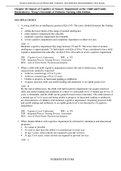
-
Chapter 18: Impact of Cognitive or Sensory Impairment on the Child and Family Hockenberry: Wong’s Essentials of Pediatric Nursing, 10th Edition
- Exam (elaborations) • 15 pages • 2023
-
- $9.49
- + learn more
1. A young child has an intelligence quotient (IQ) of 45. The nurse should document this finding as: a. within the lower limits of the range of normal intelligence. b. mild cognitive impairment but educable. c. moderate cognitive impairment but trainable. d. severe cognitive impairment and completely dependent on others for care. ANS: C Moderate cognitive impairment IQs range between 35 and 55. The lower limit of normal intelligence is approximately 70. Individuals with IQs of 50 to 70 a...

That summary you just bought made someone very happy. Also get paid weekly? Sell your study resources on Stuvia! Discover all about earning on Stuvia


